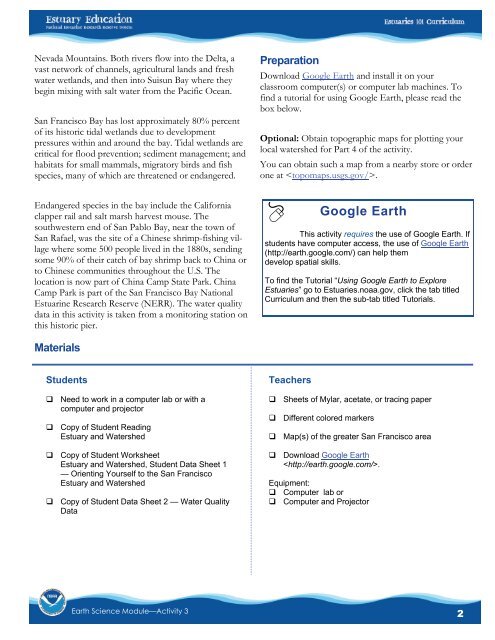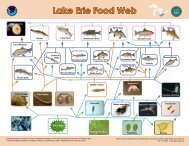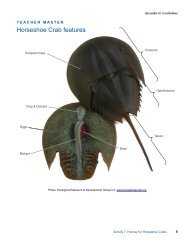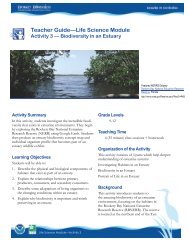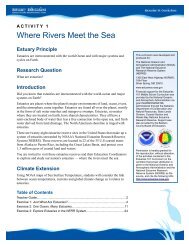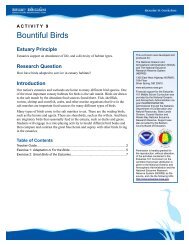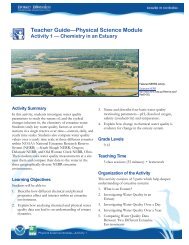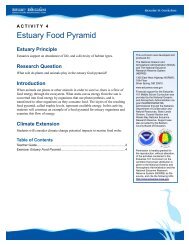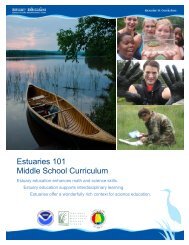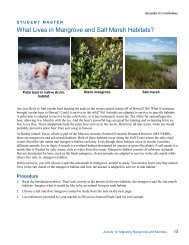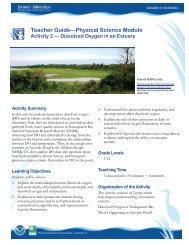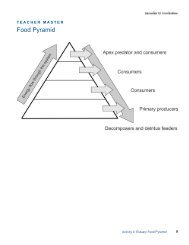Teacher GuideâEarth Science Module - Estuaries NOAA
Teacher GuideâEarth Science Module - Estuaries NOAA
Teacher GuideâEarth Science Module - Estuaries NOAA
Create successful ePaper yourself
Turn your PDF publications into a flip-book with our unique Google optimized e-Paper software.
Nevada Mountains. Both rivers flow into the Delta, avast network of channels, agricultural lands and freshwater wetlands, and then into Suisun Bay where theybegin mixing with salt water from the Pacific Ocean.San Francisco Bay has lost approximately 80% percentof its historic tidal wetlands due to developmentpressures within and around the bay. Tidal wetlands arecritical for flood prevention; sediment management; andhabitats for small mammals, migratory birds and fishspecies, many of which are threatened or endangered.PreparationDownload Google Earth and install it on yourclassroom computer(s) or computer lab machines. Tofind a tutorial for using Google Earth, please read thebox below.Optional: Obtain topographic maps for plotting yourlocal watershed for Part 4 of the activity.You can obtain such a map from a nearby store or orderone at .Endangered species in the bay include the Californiaclapper rail and salt marsh harvest mouse. Thesouthwestern end of San Pablo Bay, near the town ofSan Rafael, was the site of a Chinese shrimp-fishing villagewhere some 500 people lived in the 1880s, sendingsome 90% of their catch of bay shrimp back to China orto Chinese communities throughout the U.S. Thelocation is now part of China Camp State Park. ChinaCamp Park is part of the San Francisco Bay NationalEstuarine Research Reserve (NERR). The water qualitydata in this activity is taken from a monitoring station onthis historic pier.Google EarthThis activity requires the use of Google Earth. Ifstudents have computer access, the use of Google Earth(http://earth.google.com/) can help themdevelop spatial skills.To find the Tutorial “Using Google Earth to Explore<strong>Estuaries</strong>” go to <strong>Estuaries</strong>.noaa.gov, click the tab titledCurriculum and then the sub-tab titled Tutorials.MaterialsStudentsNeed to work in a computer lab or with acomputer and projectorCopy of Student ReadingEstuary and WatershedCopy of Student WorksheetEstuary and Watershed, Student Data Sheet 1— Orienting Yourself to the San FranciscoEstuary and WatershedCopy of Student Data Sheet 2 — Water QualityData<strong>Teacher</strong>sSheets of Mylar, acetate, or tracing paperDifferent colored markersMap(s) of the greater San Francisco areaDownload Google Earth.Equipment:Computer lab orComputer and ProjectorEarth <strong>Science</strong> <strong>Module</strong>—Activity 32


